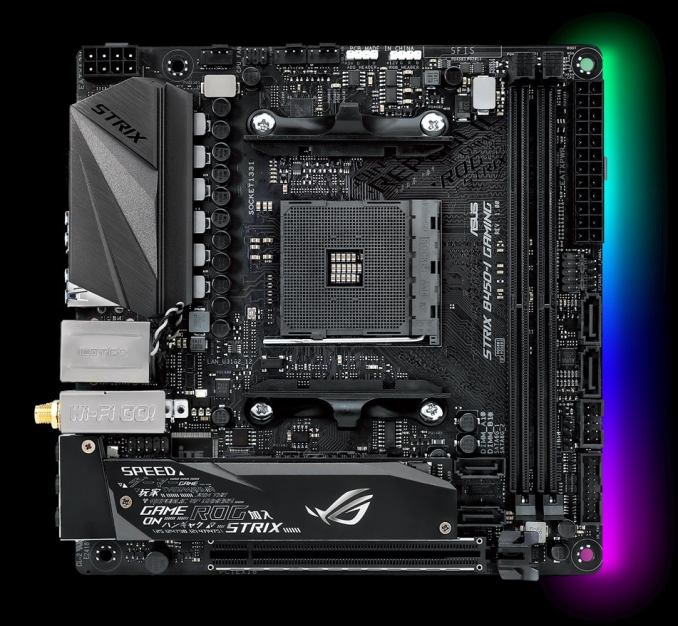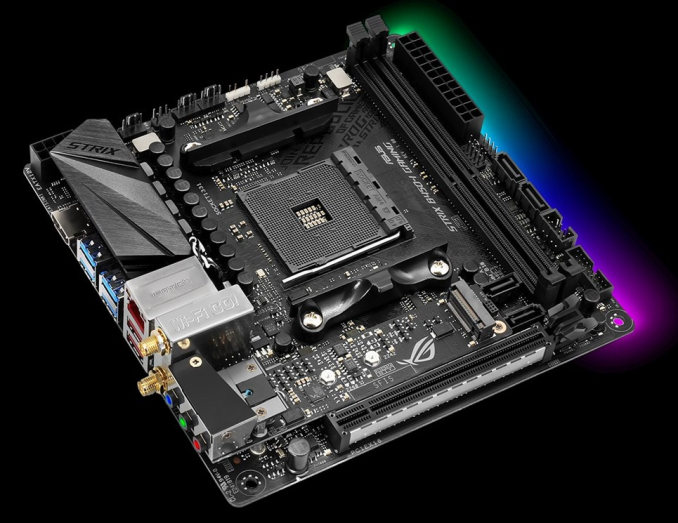Analyzing B450 for AMD Ryzen: A Quick Look at 25+ Motherboards
by Gavin Bonshor on July 31, 2018 8:00 AM ESTASUS ROG Strix B450-I Gaming
While the B450-I is the smaller sibling of the Strix B450-F, it packs a mighty punch in feature sets with a host of good quality components usually found on mITX form factor boards over the years from ASUS. The Strix B450-I includes a ROG SupremeFX S1220A audio codec with dual operational amplifiers, an Intel I211-AT Gigabit LAN controller and an Intel 802.11ac Wi-Fi adapter with MIMO capabilities built-in.
Looking closer at the Strix B450-I, the general theme follows that of the Strix B450-F board. The Strix B450-I follows a more subtle and clandestine style primarily due to its size, with a metallic grey heatsink which sits above the rear panel and MOSFETs. The RGB lighting built-in spans across the right-hand side of the board offers a unique and customizable under glow thanks to the ASUS Aura Sync technology which means it can be synchronized up with compatible peripherals and components such as graphics cards. On top of this are a single addressable RGB header and a regular RGB header.
Due to the size limitations on smaller form factor motherboards such as this one, there is only a single full-length PCIe 3.0 x16 slot which is covered in ASUS’s SafeSlot metallic armor coating to protect against slot damage from the heavier load bearing graphics cards.
Focusing on memory support, the smaller form factor has its benefits in this department as the ROG Strix B450-I supports up to DDR4-3600 with a maximum capacity of up to 32 GB of system memory split across two memory slots. Smaller form factor boards from ASUS generally tend to perform well in the memory stakes due to the closer tracks between the CPU socket and the RAM slots themselves, usually giving the memory lower latencies; although the benefits are marginal at best in real-world scenarios, they make quite a difference in situations such as benchmarking and sub-zero overclocking.
Touching more on the power capabilities, the Strix B450-I seems to feature an 8 phase Digi+ power delivery in a 6+2 configuration, with an 8-pin ATX 12 V power input to power the processor. In addition to this is a standard 24-pin ATX power connector featured on the right-hand side of the board.
The ASUS ROG Strix B450-I has a combined total of three 4-pin connectors spread across a dedicated header for a CPU fan, a single chassis fan connector and a specific connector for an AIO CPU cooler pump, or water cooling pump. Like most B450 motherboards, this particular model has a simple clear CMOS jumper instead of a button and has the capability to increase the number of USB ports through internal headers by a further two USB 3.1 5 Gbps and two USB 2.0 ports.
Making up the storage options on the Strix B450-I are four SATA 6 Gbps ports with all four of them being angled straight out of the board; we find two each on either side of the memory slots. The SATA 6 Gbps ports offer support for RAID 0, 1 and 10 arrays. In addition to the available SATA ports is a duo of M.2 slots with both slots accommodating drives up to M.2 2280 (22 x 80 mm), and both supporting the PCIe 3.0 x4 interface. One of the slots is located just above the full-length PCIe 3.0 x16 slot and features an integrated M.2 heatsink which has the futuristic text. The second slot is located on the rear of the PCB and features no cooling options other than available passive cooling from the system its installed into.
The audio is the same ROG SupremeFX S1220A audio codec found on the B450-F but is also supplemented by a pairing of operational amplifiers to further enhance the sound. Due to the size limitations, the SupremeFX S1220A codec only allows a total of three 3.5mm audio jacks on the rear panel, but they do contain an element of LED illuminated goodness; if that’s considered a selling point for an ITX board. In addition to the audio capabilities, the rear panel also has a total of four USB 3.1 5 Gbps Type-A ports and a pairing of USB 3.1 10 Gbps Type-A ports which are distinguished by their red color.
Finishing off the connections on the ROG Strix B450-I is an Intel I211-AT controlled Gigabit LAN port, two slots to attach the two included antennas to capitalize on the built-in 802.11ac MIMO 2T2R capable Wi-Fi module with Bluetooth 4.2 support, and last but most certainly not least, a single HDMI 2.0b capable video output for use with the Ryzen APUs.
It’s clear that the ROG Strix B450-I is a formidable offering featuring the same 8-phase Digi+ power delivery with two more than most ASUS B450 boards at launch, as well as a svelte integrated M.2 heatsink offering some function to users looking to utilize an NVMe capable drive in a small form factored PC, as well as some points in the style stakes too. The B450-I would be more suited to a powerful gamer with a beefy pixel rendering goliath such as an NVIDIA GTX 1080 Ti paired off with a Ryzen 2700X processor and DDR4-3600 memory for a pocket rocket gaming system. The expected retail price is currently unknown as of yet.





_thumb.jpg)
_thumb.jpg)
_thumb.jpg)
_thumb.jpg)
_thumb.jpg)
_thumb.jpg)








62 Comments
View All Comments
bi0logic - Tuesday, July 31, 2018 - link
It looks like the price link to the "TUF B450-Plus Gaming" is going to an amazon search for "ASRock B450M Pro4"eastcoast_pete - Tuesday, July 31, 2018 - link
Thanks Gavin, I know this is a lot of information to go through and present. I would love to see a follow-up on these questions:1. Especially for these compact boards, any problems with stock processor heat sinks blocking DIMM slots, i.e. do DIMMs with heat spreaders still fit with a Wraith or Spire cooler, respectively?
2. I have my eye on the Aorus Pro WiFi or something similar, but am wary of the placement of the WiFi antenna connectors right next to two of the USB 3 connectors. I frequently use 3-4 USB 3 devices at the same time frequently, and am wary of the USB 3 - WiFi interference with that placement. Any chance Gigabyte could state if/that they got that taken care of?
Thanks!
Also, still looking forward to your Ryzen 2200/2400 GPU overclock chapter on that duo. Any chance we'll see it soon?
sonofgodfrey - Tuesday, July 31, 2018 - link
Second to last table is labeled X470 Motherboards.PingSpike - Tuesday, July 31, 2018 - link
It looks like the ASUS ROG STRIX B450-F GAMING inherits some of the layout features of the (much more expensive) x470 Crosshair 7 in that it steals some of the CPU lanes to get a second full PCI-e 3.0 M.2 slot. Then 8x goes to PCI-e 16 1, the remaining 4x to PCI-e 16 2 and finally a chipset PCI-e 2.0On the surface, this seems like it has totally ignored the bifrucation limitations that supposedly are inherent to the B450 chipset.
In other words, I thought you couldn't get that on this chipset.
Dragonstongue - Tuesday, July 31, 2018 - link
well at least the pricing is "more inline" with the pricing they should be, newer boards, better componentes that actually save the maker a bit of coin per board made, so they keep the same "launch price" is acceptable in my books coming from gen 1 (I so hate the naming AMD used for Ryzen 1xxx and 2xxx needless confusion for nothing)x3xx to x4xx same concept, reduced price to produce so they save some money, but the vast majority of vendors used these "savings" to cram more disco light show RGB on the boards to jack the price up some instead.
seems at least with the B4xx boards the vendors took a "better" approach beyond a few more "premium" boards which rightfully have an increased price (justifiable, maybe, but I myself have zero need of RGB and would only buy a more expensive board that offered them at the increased price if they were WORTH it as far as just overall better then lower cost boards, sadly, there seems to be little difference in more "premium" beyond a butt load of extra RGB little better in VRM etc which are much more useful and required IMO)
they could almost have a market for the premium boards RGB free, so pay a bit less for people like me who do not want all the RGB crud but still get the increased premium sound/VRM/BIOS etc ^.^
WasHopingForAnHonestReview - Wednesday, August 1, 2018 - link
Nice review. Good work.Im amazed that almost every comment is a nitpick. Rough life, Ian.
Flappergast - Wednesday, August 1, 2018 - link
Nice overview on the last page. I’m looking for mITX WiFi - nice to see some good boardsSakkura - Wednesday, August 1, 2018 - link
As documented by Buildzoid, the Asrock B450 Pro4 does not have the claimed 6+3-phase VRM. It is a pure 3+3-phase. Same probably applies for the B450M Pro4.https://youtu.be/yWAwOH-egFs?t=2104
JohanPirlouit - Wednesday, August 1, 2018 - link
Hi everyone,Am I the only one to see that on the AMD picture:
- CPU: 2x SATA 3Gbps
- Chipset: 6x SATA 3Gbps
What do AMD talks about: SATA "3" (known as "6Gbps") or SATA 3Gbps (aka SATA II)?
Sakkura - Wednesday, August 1, 2018 - link
They mean SATA3 = SATA 6Gbps. Annoying that we keep running into these easily confused naming schemes (see also: USB 3.1 Gen1 and Gen2). At least SATA is getting old enough that we should soon be able to just drop the version number (unlike USB 2.0 there's really no reason to make modern hardware with SATA2).